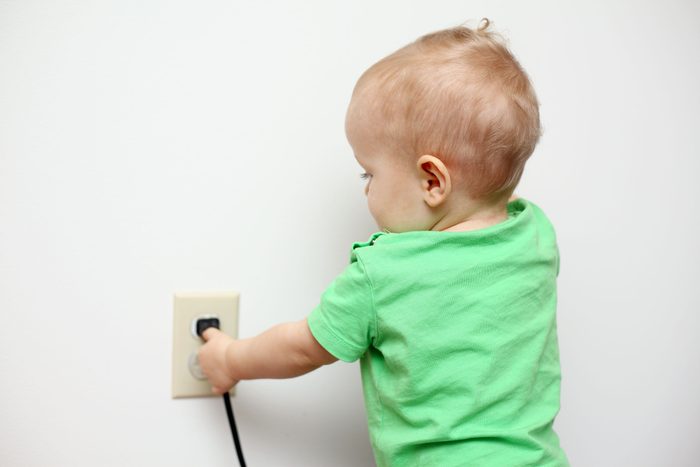Electrical Safety Tips for Parents

With all their gadgets, kids are around electricity pretty much from birth. Keep your little ones safe with these electrical safety tips for parents.
Our editors and experts handpick every product we feature. We may earn a commission from your purchases.
Electricity is a mysterious, complicated force. We depend on it, but we don’t really “get” it. And if we don’t understand electricity, a child must think it’s magic.
That’s why it’s so critical to watch for and mitigate electrical hazards in your home, and to teach kids electrical safety from an early age. Kids account for 20 percent of all electrical injuries, with most happening at home. Toddlers and adolescents are at higher risk.
Short of living off the grid, which has its own dangers, there are things you can do to make your home electrically safer for kids. Before taking these on, turn off the power at the breaker/service panel and test it to be sure it is off before working on any circuits.
And be sure to call a licensed electrician to perform any work beyond your comfort or experience level.
On This Page
Install Tamper-Resistant Receptacles
Electrical receptacles hold a certain fascination for kids. Every year about 2,400 kids are injured from sticking something in them.
Unlike plastic outlet plugs, tamper-resistant (TR) receptacles cannot be bypassed by a determined kid with a fork. Tamper-resistant receptacles have an interior shutter that only opens if an electrical plug is evenly inserted into the slots. Since 2008, the National Electrical Code (NEC) requires them in new residential construction.
What you can do:
- Check all receptacles for “TR” stamped on the face;
- If there’s no “TR,” replace the receptacles for about $1.50 each.
Test and Maintain Your Garage Door Auto-Reverse
Electric photo eyes and auto-reverse capability are required safety features on automatic garage door openers sold since the early 1990s. Before these requirements, crushing injuries and fatalities, often of children, were much more common.
What you can do:
- Test your garage door as recommended by your garage door manufacturer;
- Clean the electric eye sensors with a soft cloth and realign them, if necessary.
Call an electrician or garage door repair service if you see any loose or frayed wires, or if the door fails to reverse when tested.
Install Voice-Alert Smoke Alarms
More than half of young children who die in home fires every year are asleep when the fire occurs. Make sure you have smoke detectors that work.
Studies on the response time of children to smoke alarms show sleeping kids overwhelmingly respond to voice and hybrid voice-tone signals (85 to 89 percent) more than tone only (56 percent).
What you can do:
- Replace tone-only models with voice-alert or hybrid ones;
- Install smoke detectors in every bedroom, outside all sleeping areas and on every floor of your house;
- Test smoke alarms monthly and replace them every 10 years.
Install Arc-Fault Circuit Interrupters
Arc faults due to frayed cords and damaged wiring are both common causes of residential fires.
If your house is more than 10 years old, you probably don’t have arc-fault circuit interrupter (AFCI) protection on every circuit, which the NEC now requires for new construction. This includes bedrooms, kitchens, hallways, living rooms, dens, laundry rooms and more. It’s almost every room in your house, so check your local codes to make sure you get them all.
House fires kill 500 children every year, so updating your home’s AFCI protection is worth it.
What you can do:
- Swap out regular breakers for AFCI breakers, or …
- Install AFCI receptacles on the first outlet of each circuit.
Don’t Run Cords Under Rugs
Cords hidden under rugs and carpeting are dangerous. If they become damaged due to foot traffic or excessive heat, they can arc and start a fire before you can even figure out where that smell is coming from.
Electrical arcs cause shocks, too, and kids spend a lot of time crawling around and playing on the floor.
What you can do:
- Keep wires against walls, if possible;
- Use cord protectors;
- Bring power to a new outlet in a more convenient location;
- Install a new tamper-proof receptacle.
Cover Surge Protectors and Power Strips
The blinking lights, buttons and tentacle-like cords of surge protectors and power strips are catnip to crawlers and toddlers. If they manage to pull a plug partially out of the socket, it’s easy for their little fingers to slip onto the prongs before the electrical connection has been severed, causing a shock.
What you can do:
- Install surge protector covers on all power strips in your home;
- Hang them on the wall out of your child’s reach, if possible.
Install Receptacle Covers and Cord Shorteners
Biting into electrical cords and sticking objects into receptacles are leading causes of shock in young children. Little hands are grabby, and unattended cords and plugs offer an irresistible target.
You can’t get rid of every cord and plug in your home — we do need lamps, after all. Make dangling cords and plugs inaccessible to little teeth and fingers with receptacle covers with cord shorteners.
What you can do:
- Unplug the device and turn off the power;
- Install cover and shortener according to manufacturer directions;
- Wind excess cord around shortener, plug in the device and cover the outlet;
- Install cord protectors if the cord is still accessible.
Install Ground-Fault Circuit Interrupters
The NEC requires ground fault circuit interrupter (GFCI) protection in bathrooms, kitchens and other places where water is present. GFCIs protect against electric shock by opening the circuit if it detects extra current that could be going to a person.
GFCIs have reduced electrocutions by 83 percent since they were first introduced in the early 1970s. So it’s really worth determining if your house is up to code. GFCIs, at around $20, are more expensive than regular receptacles, but the peace of mind will be worth it.
What you can do:
Don’t Plug in Phones in the Bathroom
Teens and phones are rarely separated, but teach your big kids to keep chargers out of the bathroom. The temptation to reach for the phone right out of the shower or while in the bath is too great, with sometimes devastating results.
Electrocution can occur even with GFCI protection.
What you can do:
- Cover all bathroom receptacles when children are young;
- Educate kids on bathroom electrical safety;
- Don’t charge your phone in your bathroom — kids mimic your behavior.
Store Electrical Appliances and Devices out of Reach
Kids pull themselves to stand at around nine to 12 months. If you’ve got an appliance with a dangling cord, it might appeal to a child looking for a boost.
Babies and toddlers can strangle on electrical cords. And if they pull an appliance, computer or TV on top of themselves, they can be killed or severely injured.
What you can do:
- Unplug and put away all non-critical appliances and electrical devices when not in use;
- Secure loose cords for permanent appliances behind cord protectors or furniture.
Educate Kids about Electrical Safety
No matter the age, kids must be taught to respect electricity and be aware of safety hazards.
- Never stick anything (forks, bobby pins, fingers) into an outlet;
- Run the other way and find an adult if you see a downed power line;
- Never touch electrical devices — including plugged-in phones and laptops — while swimming, bathing or still wet from either activity;
- Don’t yank cords out of the socket by the cord;
- Never put electrical cords, plugs or devices in your mouth.



